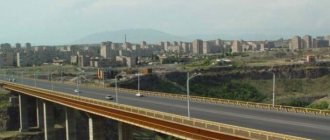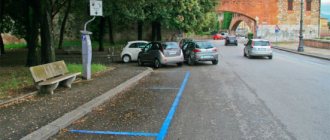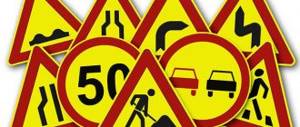In addition to the usual markings that are applied to the roadway, there are vertical markings. From the name it is clear in what spatial position it is located. But why do road workers complicate traffic rules? Are ordinary markings and road signs not enough? It turns out that no. This element of sign instructions in the rules of the road is of a warning nature, designed to attract special attention from the driver. Let's still figure out for what purposes our roads are marked with such unusual markings.
Why do you need vertical markings?
Vertical road marking lines are used to paint road objects in order to inform the driver of approaching danger. As the vehicle moves, it encounters elements of overpasses, overpasses, tunnels and other structures that are located very close to the roadway. If during the day such supports can be seen long before approaching them, then at night they can often be invisible to the human eye.
In order to highlight such structures, this marking is used. Traffic regulations specifically determine the order of designation of all road objects that the driver may encounter along the entire route.
Objects requiring designation.
- Support columns for bridges, overpasses and overpasses.
- Curbs and bollards that enclose traffic islands.
- Side fencing elements of the road.
- Lamp post supports.
- Trees, as well as other elements or parts thereof, which are located closer than one meter from the edge of the roadway.
Each object that is located closer than 1 meter from the roadway must be marked with a special type of vertical marking defined in the traffic rules. Such elements are indicated by painting them with reflective paint. If, due to certain properties of the object, it is impossible to paint it, then a sheet of galvanized metal is painted, or a plastic picture is used.
Lecture notes SDA Vertical markings
Topic 4.2. Vertical markings.
A road is not only a smooth road surface, it is also all kinds of road structures, which, on the one hand, are designed to improve road safety or increase the capacity of the road, and, on the other hand, are themselves a physical obstacle that you can hit , if you don’t notice it in time.
What is meant? For example, if instead of an intersection you build a two-level road junction, this is good - the capacity of both roads has become significantly higher, and intersecting traffic flows do not conflict with each other. But at the same time, overpass supports have appeared on the lower road, which drivers need to safely avoid, and from the upper road you can generally fall, breaking through the enclosing parapet.
To improve the visibility of road elements, they are painted as a zebra stripe. This is vertical road markings - a combination of white and black stripes applied to the vertical surfaces of various road structures.
And the various road structures are this:
Bridge supports, lighting poles and even trees (if they are located within the curb).
Span structures of bridge structures and tunnel portals.
Dividers, raised traffic islands, traffic islands, curbs.
Round bollards located on medians, raised guide islands or raised traffic islands.
Signal posts.
Road barriers.
In front of us is a two-level road junction.
Please note that the support of the bridge structure closest to us has inclined black and white stripes.
These markings indicate vertical obstacles located within the road.
But not everything! But only those that pose a danger to moving vehicles.
GOST R 52289-2004 includes such vertical obstacles (posing a danger) not only as bridge supports, but also as lighting poles, and even trees growing on the side of the road, as long as they are located at a distance of less than 1 m from the edge of the roadway.
Markup 2.1.1, 2.1.2, 2.1.3
– designates elements of road structures (bridge supports, overpasses, end parts of parapets, etc.),
when these elements pose a danger to moving vehicles.
Marking 2.1.1 is applied to an obstacle that can only be driven around on the right.
Marking 2.1.2 is applied to an obstacle that can be driven around on both sides.
Marking 2.1.3 is applied to an obstacle that can only be driven around on the left.
The driver of a passenger car does not need to worry whether he will pass under this tunnel ceiling. And for a container ship, the height of the span may be insufficient.
Therefore, all spans of bridges, overpasses, tunnels, overpasses located below 5 meters above the road surface are marked with special markings 2.2 (alternating vertical lines of white and black).
Markup 2.2
– designates the lower edge of the spans of bridge structures and tunnel portals located at a height of less than 5 m.
The markings are applied above the middle of each lane along which movement is carried out towards the structure.
This raised safety island is equipped with two round pedestals. In order to make them clearly visible to all road users, vertical markings were applied to the bollards.
Markup 2.3
- used to designate round bollards in cases where they are located on median strips, raised guide islands or raised traffic islands.
And these are the so-called signal posts. They are installed on sections of roads that do not require more serious fencing, painted white and a wide inclined stripe of black is applied. At the same time, the guide posts are equipped with special reflective devices so that they can be clearly seen even in the dark.
Markup 2.4 –
It is applied to signal posts and is a wide inclined strip of black color.
Signal posts are installed on the side of the road at a distance of at least 1.0 meters from the edge of the roadway.
On sections of roads where, for safety reasons, it is necessary not only to mark the edge of the roadway, but to install reliable side guards, these very reliable side guards will be installed.
One example of the use of such side barriers is on sections of roads at multi-level intersections.
The same fencing is also installed at dangerous curves on ordinary flat roads.
The same fence is installed on a straight section of the road, unless there are steep slopes on the right and left, and any exit from the road is deadly.
Markup 2.5 –
vertical alternating black and white stripes.
This marking is used to mark the side surfaces of road barriers on dangerous
sections of roads.
On other sections of roads that are not particularly dangerous, side barriers may also be present.
Only the markings on them will be different - along the entire length of the fence on a white background there will be a wide black stripe.
Markup 2.6 –
wide black stripe on a white background.
Such markings are used to mark the side surfaces of road barriers on other sections of roads that do not apply to cases where marking 2.5 is used.
Elements of road equipment can also be dangerous for drivers, for example, high sidewalk curbs on some specific sections of roads.
On such sections of roads, wide vertical black stripes are also applied to raised curbs.
Markup 2.7 –
vertical black lines on a white background.
Such markings are applied to the side surfaces of raised guide islands, traffic islands and curbs located at a distance of less than 1 m from the roadway.
We've run out of paint, they'll be back soon and will definitely apply it. 2. They did everything right. Such markings are not applied to all vertical elements of the road, but only to those that pose a danger. The markings have already done their job, they have attracted attention, and now drivers will pass this place with all the necessary caution. |
This vertical marking marks the lower edge of the span of tunnels, bridges and overpasses. But who will see her in the dark? 1. It’s good that it’s visible during the day. 2. Vertical road markings are applied with special paint, and at night they are also clearly visible in the headlights. |
1. This is a beautiful stretch of road. 2. This is a dangerous section of the road. |
1. This is a dangerous section of the road. 2. No, this section of the road is not particularly dangerous. The danger is most likely the road fence itself. And in order to protect drivers from an accidental collision with the fence, it was painted white and a black stripe was applied for contrast. |
1. For beauty. 2. This is a vertical road marking. These markings mark curbs on dangerous sections of roads. |
Types of vertical markings
Certain vertical markings of traffic rules are applied to various elements of the road infrastructure. For convenience, existing State Standards, as well as current traffic rules, have adopted a single numbering of symbols.
2.1 – applied to the vertical parts of automotive components. Usually these are support posts of overpasses or bridges, supports of bridge barriers. This designation applies to elements that extend in their parts into a meter zone from the edge of the roadway, or from horizontal road markings. If the designated object is massive, only part of it is painted: 0.5 meters in width and up to 2 meters in height.
This marking has varieties that are determined by indicating the direction to avoid the obstacle. So, right-hand, left-hand, and also a detour on both sides can be indicated.
2.2 – indicates the upper limit of the span. It can be found where the distance from the upper edge of the road to the lower edge of the artificial structure is less than five meters. These can be the lower parts of overpass spans, the upper boundaries of tunnels, as well as other elements that are located directly above the roadway.
The marking element is made in the form of alternating vertical black and white stripes. It is installed above the middle of the traffic lane or a solid line above the entire surface of the roadway.
2.3 – indicated in the form of horizontal alternating white and black stripes. Concrete columns called pedestals are painted with it. These posts are installed at the beginning of the dividing strip, as well as in the area of traffic islands.
Road markings numbered 2.1 – 2.3 are applied directly to the designated element. If the road situation does not allow the installation of lighting devices, then it is applied with a special paint that is reflected in the headlights. If it is impossible to paint the element itself, a pre-painted road sign is attached to it.
2.4 – applied to boundary posts or sign posts. It can also be found on the supports of road fences. It is similar to markup number 2.1. The difference is one oblique stripe on the column. The strip is tilted towards the roadway. This is done to mark the edge of the road.
2.5 – applied to the fence along the road. Such a fence is installed right at the edge of the road surface in especially dangerous places. In this case, the length of the section on which black and white stripes are depicted must be at least 10 meters.
Most often, this designation can be found on small-radius road turns, or in places where there is a steep slope behind an almost non-existent shoulder. It is also present at all bridge crossings. In general, this marking indicates to the driver the places where there is danger behind the road fence.
2.6 – performed as a straight solid line. It is applied in all other cases, except for cases in which marking 2.5 is required.
2.7 - mainly applied to curbs. It marks the boundaries of sidewalks, safety islands and other elements that, due to their design, rise above the roadway. In addition, it is used to designate places where vehicle traffic is allowed strictly in a straight direction, without the possibility of moving to the side of the road. The curb application method, as well as when painting traffic islands, differs.
Vertical markings (Appendix 2. Traffic regulations of the Russian Federation)
/ Traffic regulations / Markings / Vertical
Traffic regulations SignsMarking Vehicle approval
Markup:
Vertical markings in the form of a combination of black and white stripes on road structures and elements of road equipment show their dimensions and serve as a means of visual orientation.
- 2.1.1 2.1.2 2.1.3
2.1.1, 2.1.2, 2.1.3 – designate elements of road structures (bridge supports, overpasses, end parts of parapets, etc.), when these elements pose a danger to moving vehicles;
2.2
2.2 — denotes the lower edge of the span of tunnels, bridges and overpasses;
2.3
2.3 - denotes round bollards installed on dividing strips or traffic islands;
2.4
2.4 — denotes guide posts, grooves, fence supports, etc.;
2.5
2.5 - designates the side surfaces of road fences on small radius curves, steep slopes, and other dangerous areas;
2.6
2.6 - designates the side surfaces of road fences in other areas;
2.7
2.7 - denotes curbs in dangerous areas and raised traffic islands.
Example of using vertical road markings:
Comments (2)
Geralt of Rivia
07/08/2019 at 16:11 Where can I find the operating rules for the Roach?
[Reply] [Cancel reply]+11 ANNA
09/03/2017 at 15:09 ooo
[Reply] [Cancel reply]+3 coming
News
03/26/2021 Changes in the practical part of the traffic rules exam from April 1, 2021
03/01/2021 New sign 6.22 “Photo and video recording” in traffic rules
All news
© 2010-2020 Exam-SDA-Online.rf | Email | Site map Theoretical online traffic rules exam using official tickets of the Road Traffic Safety Inspectorate of the Ministry of Internal Affairs of the Russian Federation
Traffic Laws
1. General provisions 2. General responsibilities of drivers 3. Application of special signals 4. Responsibilities of pedestrians 5. Responsibilities of passengers 6. Traffic lights and traffic controller signals 7. Use of emergency signals and warning triangles 8. Start of movement, maneuvering 9. Location of vehicles on the roadway parts 10. Speed 11. Overtaking, ahead, oncoming passing 12. Stopping and parking 13. Driving through intersections 14. Pedestrian crossings and stopping places for route vehicles 15. Traffic across railway tracks 16. Traffic on highways 17. Traffic in residential areas 18 Priority of route vehicles 19. Use of external lighting devices and sound signals 20. Towing of motor vehicles 21. Driving instruction 22. Transportation of people 23. Transportation of goods 24. Additional requirements for the movement of cyclists and moped drivers 25. Additional requirements for the movement of horse-drawn carts , as well as for driving animals 26. Standards for driving and rest time
Road signs
1. Warning signs 2. Priority signs 3. Prohibition signs 4. Mandatory signs 5. Special requirements signs 6. Information signs 7. Service signs 8. Additional information signs (plates)
Road markings
1. Horizontal marking 2. Vertical marking
Basic provisions and malfunctions
Basic provisions for authorization of a vehicle for operation List of malfunctions for which operation of the vehicle is prohibited
Additional materials
First aid in case of an accident
Regulatory regulation
Application parameters, as well as the dimensions of vertical marking stripes, are determined by GOST 13508-74. Road markings”, as well as “GOST 23457-86. Technical means of organizing traffic."
These two documents fully describe all the requirements for applying vertical markings to road facilities:
- line thickness;
- tilt angle;
- procedure for use and installation;
- use of reflective paint and elements;
- installation locations, etc.
Traffic rules indicate links to state standards that are valid at the time of their preparation. This makes it possible to avoid ambiguity in understanding the rules, and to ensure strict compliance by all officials with the requirements for handling vertical markings.
Post Views: 14










